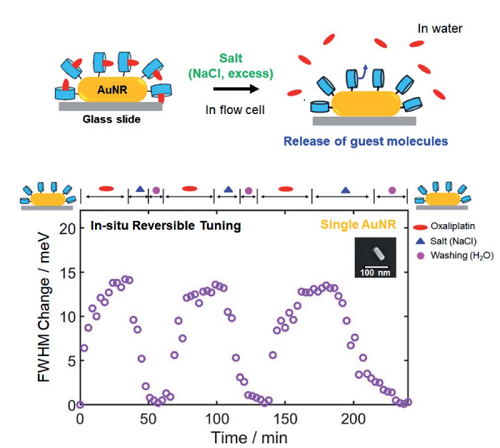| In situ reversible tuning of chemical interface damping in single | |||||
| 작성자 | 전** | 작성일 | 2021-11-24 | 조회수 | 214 |
|---|---|---|---|---|---|
|
In situ reversible tuning of chemical interface damping in single gold nanorod-based recyclable platforms through manipulation of supramolecular host?guest interactions, Chemical Science, 12, 7115 to 7124 (2021) DOI : 10.1039/d1sc01204e
Abstract Recently, chemical interface damping (CID) has been proposed as a new plasmon damping pathway based on interfacial hot-electron transfer from metal to adsorbate molecules. It has been considered essential, owing to its potential implications in efficient photochemical processes and sensing experiments. However, thus far, studies focusing on controlling CID in single gold nanoparticles have been very limited, and in situ reversible tuning has remained a considerable challenge. In these scanning electron microscopy-correlated dark-field spectroscopic measurements and density functional theory calculations, cucurbit[7]uril (CB[7])-based host?guest supramolecular interactions were employed to examine and control the CID process using monoamine-functionalized CB[7] (CB[7]-NH2) attached to single gold nanorods (AuNRs). In situ tuning of CID through the CB[7]?oxaliplatin complexation, which can result in the variation of the chemical nature and electronic properties of adsorbates, was presented. In addition, in situ tuning of CID was demonstrated through the competitive release of the oxaliplatin guest from the oxaliplatin@CB[7] complex, which was then replaced by a competitor guest of spermine in sufficient amounts. Furthermore, nuclear magnetic resonance experiments confirmed that the release of the guest is the consequence of adding salt (NaCl). Thus, in situ reversible tuning of CID in single AuNRs was achieved through successive steps of encapsulation and release of the guest on the same AuNR in a flow cell. Finally, single CB[7]-NH2@AuNRs were presented as a recyclable platform for CID investigations after the complete release of guest molecules from their host?guest inclusion complexes. Therefore, this study has paved a new route to achieve in situ reversible tuning of CID in the same AuNR and to investigate the CID process using CB-based host?guest chemistry with various guest molecules in single AuNRs for efficient hot-electron photochemistry and biosensing applications. |
|||||
- 첨부파일
- 4-2.png


